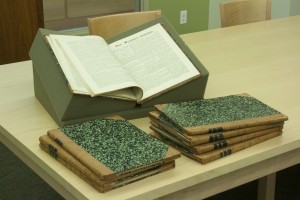As part of our celebration of Women’s History Month, The Albert M. Greenfield Digital Center for the History of Women’s Education will be showcasing content from March issues of The Woman’s Column, a very exciting recent acquisition of Bryn Mawr Special Collections. Published between 1887 and 1905 and edited by Alice Stone Blackwell, The Woman’s Column was a weekly newsletter focused on developments in suffrage and other related women’s rights issues. Its better-known sister publication, The Woman’s Journal (1870 – 1931), is more widely available,  but thus far we have been unable to locate a print collection of the Column that is as complete and well-preserved as the one we have acquired. We are currently taking steps to have the entire collection digitized and made available for free on Internet Archive.
but thus far we have been unable to locate a print collection of the Column that is as complete and well-preserved as the one we have acquired. We are currently taking steps to have the entire collection digitized and made available for free on Internet Archive.
The original purpose of the Column was to serve newspapers with a regular source of copy on women’s suffrage, but private subscribers soon became numerous as well: at only 25 cents per year, it was an easy and relatively inexpensive way to keep a finger on the pulse of the women’s rights movement. A quick glance through its collected pages shows that it kept its readers apprised of a wide variety of happenings: in addition to regular updates on the various regional, national, and international legislative battles over women’s rights, the Column also published concise rebuttals to common anti-suffrage arguments, profiles of influential women and career success stories, and opinion articles regarding women’s role in society.
Content about the availability of education to women, especially higher education, was a regular feature of The Woman’s Column. Articles appeared nearly weekly detailing developments in the policies of specific schools, changes in legislation, updates on women’s education in specific regions or abroad, and profiles of notable college women. Occasionally the magazine would publish a piece collecting tidbits from many different institutions, such as the one featured here.
This article serves as a very broad account of the happenings of various American institutions, ranging from fund-raising updates and a notification of new fellowships to be offered by Bryn Mawr, to the lighter recounting of the Women’s Medical College of Chicago’s first celebration of “University Day” since becoming a department of Northwestern University. The Column describes the festivities as lively indeed, “characterized by college songs, college yells, college pranks and college jollity,” but also assures the mindful reader that “as it was conducted on the co-educational plan, nothing discreditable occurred.”
What does this article tell us about the publication, about the way women’s education was approached in the late 19th century, and about the culture of the women’s rights movement? It is notable that the article does not contain any direct mentions or links to suffrage, which was seen as the key motivating issue of the publication. The frequency and scope of the education-related content in this issue and others speaks to the degree to which women’s higher education was considered to be germane to the women’s rights movement, since education-related content did not need to directly reference suffrage to be considered worthy of inclusion in the pages of The Woman’s Column. Both suffrage and education were important sites of leverage for increasing women’s role in the public sphere, and for giving them greater capacity to shape their own lives. It also suggests that the readers of the magazine, and women interested in suffrage in general, would be invested in the cause of women’s education perhaps because they were largely college graduates themselves. If The Woman’s Column audience did not have a personal background that included college culture, it seems doubtful that the items focused less on legislation and more on social events, such as the account of the “University Day” celebrations, would have been featured.
We will be featuring a different excerpt from The Woman’s Column every week throughout March to celebrate this important new acquisition and to mark Women’s History Month. For further reading on the history of the publication, or on Alice Stone Blackwell and her mother, Lucy Stone’s influential role in shaping the voice of the women’s rights movement, the following sources are recommended:
Women’s Periodicals in the United States: Social and Political Issues, edited by Kathleen L. Endres, Therese L. Lueck
Lucy Stone: Pioneer of Woman’s Rights, by Alice Stone Blackwell

